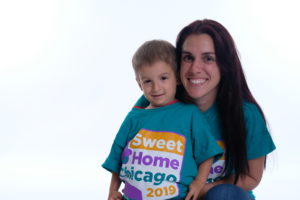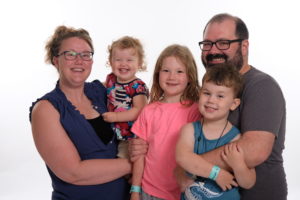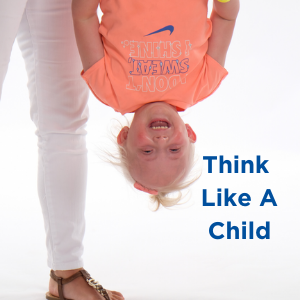In her book Raising Charitable Children, Carol Weisman, internationally recognized philanthropy expert (and full disclosure – a friend of mine), discusses how to instill a sense of giving in children – and then watch them develop into generous, responsible, thoughtful, kind, loving and happy adults.
Carol beautifully sums up her approach in one simple line:
“Sometimes the cookies you give away taste the best!”

What a powerful message! Carol shares how her young son, Teddy, learned this valuable lesson after a trip to the Fort Bragg Army Hospital where their family handed out Christmas cookies to patients and staff. It made him feel good and proud to make others happy.

The Beauty of Gratitude
We all know this. Helping others just plain makes you feel good! When we reach out in kindness – and then see joy in someone’s eyes, the smile of a child, or the gratitude on an elderly person’s face – we experience a sense of warmth, contentment and joy.
It turns out that caring about and helping others is vital in becoming a happy, well-adjusted, successful adult. Research shows that empathy helps each of us to become more likable, more employable, better parents, good friends, strong leaders, more conscience-driven and even increases our lifespan. Furthermore, sociologists report that care for others is a key building block in creating a positive, value-based community.

They’re Always Watching
Our children are learning all the time. And it starts at a very early age. Studies show that generosity and empathy begins in children as early as six months old.
Unfortunately, we aren’t born automatically caring about others or with a desire to help those less fortunate or unequipped to effectively help themselves. We must be taught. A study by Grey Matter Research shows that parents have a huge influence on whether or not their children will grow up to become charitable-minded adults. Here’s what they learned:
- We are 145 times more likely to volunteer if our parents frequently volunteered.
- Among those who say their parents gave money to a church while growing up, 55% now do the same.
- For those whose parents did not donate, only 24% make charitable contributions.
Be conscious of what are you teaching your young children through your words and through your actions. Observational learning (what they see you do) is one of the primary mechanisms of early childhood learning. What kind of a giver are you? Are you kind and generous in your interactions? Do you recognize generosity in others? Be sure to talk (but not brag) about your giving activities. Explain why it’s important to you and to the person you are helping.

Tips on Teaching Empathy
As parents, we can we instill a charitable mindset in our children so they can experience the joy of giving at a young age.
1. Show your children real-world needs.
Find ways to teach your kids, firsthand, about the real needs of others. Pick something relatable, positive and age-appropriate. For example, a giving tree at church or a food drive at school are good ways to talk to your children about a family dealing with unemployment, kids whose parents can’t afford holiday gifts, an elderly neighbor needing help shoveling their sidewalk, or a family without enough to eat. These needs are current, tangible, and understandable teaching moments about the importance of helping others.
2. Explain what giving means – to you and to those you are helping.
Talk with your children about your own giving. When did you start giving? What kind of giving is important to you – and why? Then ask your child what is important to them? Find something that resonates, that they care about. Then together, come up with a way for them to give that is meaningful to them.
Last year, in “A Beautiful Day in the Neighborhood,” Tom Hanks played Mr. Rogers, a man universally recognized as a leader in guiding young children through a PBS series focused on kindness and community. When I was young, his quote,
“Look for the helpers,”
planted a seed deep in my heart – and in the heart of many of my peers who also grew up in the 60’s. I still think back on the spirit of this simple piece of wisdom.
Talk to your children about the helpers in your life – the teachers, the care givers, the pastors, and the kind neighbor who shares fresh baked cookies. In these times of COVID-19, it’s important that we help our children see that our world is filled with good people – with helpers. And we need to work with them to show how we, too, can be the helpers!
3. Make giving a family value.
It’s important to involve the entire family in your giving. Have a family giving strategy. What is your family’s “charity of choice”? Why is it important to you, to someone you care about, to your children, to your community?

Talk about it at the dinner table, in the car as you’re dropping off items for a food drive, and as you mail a donation for a cause important to you. It’s important for every family member to take part in these conversations. Help your son learn the language of giving. Help your daughter identify a way to help someone she’s worried about.
4. Help your child find their passion
Help each of your children start their own “helper’s fund.” Work with your child to find something that they care about, and allocate a portion of their allowance to that cause. Then work with each one of them to decide how and when to use their fund to help their cause.
Don’t worry so much about what they select – their passion will change as they get older. If your 6-year-old loves to ride her bike, have her work to raise money to donate a bicycle to an organization that donates bikes to underserved kids. If your 9-year-old enjoys baking, work with him to make treats to bring to a local nursing home.
Let each of your children drive their own giving bus (with some loving direction from you). Their journey and their passengers will amaze you!
5. Back up your words with actions.
Kids are quick learners. If they see all talk and little or no action, they’ll immediately recognize it for what it is…empty words. Giving must be a regular, top-of-mind thing. Once a year isn’t enough for a child to become charitable. Work with your child to find simple ways to give – both regular and spontaneous – like baking cookies for an elderly neighbor, singing at a senior center, or donating one of their birthday gifts to another child. Help them discover charitable ways to experience goodness.
When possible, include them in volunteering, fundraising, and donating. Have the kids help you clean the church (no, it’s not always going to be fun!), allow your son to put the donation in the red kettle, and encourage him to add some of his own money. Have your daughter ask a family friend or a grandparent for a donation to your family’s chosen charity.
Be sure to talk to your children about the other ways you help others – your service on a nonprofit board, helping organize their school book fair, or serving on the church council. It all matters.
6. Acknowledge goodness & teach gratitude.
Just as children must learn empathy, they must also learn gratitude…to express it and to receive it. Help them understand how important saying thank you is, and how good it feels to hear it.
When you see someone act in a kind and giving manner, point it out, compliment the behavior, and talk about why it matters. Similarly, whenever your child acts in a kind-hearted way, be sure to say so. And be specific. Thank them for being kind, for helping with something, for volunteering. And recognize how their action helped someone else. Also, allow your kids to overhear you praising their giving qualities to others (without them thinking you know they’re listening).
Make writing thank you notes a fun, family activity. Get together to write your holiday thank you cards, serve hot cocoa and cookies, and share memories of your favorite giving (and receiving) moments of the season.
The cookies you give away really do taste best!
As parents, it’s not only important for us to demonstrate charitable giving, but to also discuss our giving with our children and to use it as teachable moments to explain our own values of giving.
So the next time you are with your son or daughter and stop to lend a hand, drop off a donation, or buy Girl Scout cookies for a shut-in neighbor, take a moment to explain why. And maybe when they become a parent, they’ll show their children how to find joy by giving away some of their cookies!





